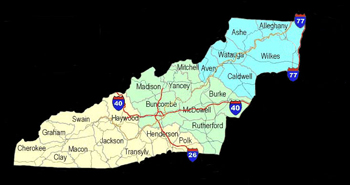Tryon County was formed
from Mecklenburg County in 1768. Old Tryon County was divided
into Lincoln and Rutherford Counties in April 1779. Rutherford
County was named for Brigadier General Griffith Rutherford
of Rowan County , North Carolina; Brigadier General Rutherford
was a famous Revolutionary War soldier.
Gilbertown, served as the first county seat from 1779 to
1787. It was named for William Gilbert. The people complained
about the muddy condition around the courthouse and Gilbertown.
This mud made it difficult for them to reach the courthouse.
Although the courthouse was at Gilbertown, the first county
court session to be held in Rutherford County was in the
home of Colonel John Walker on Cain Creek. At this session
of the County Court of Pleas and Quarter Sessions, the following
appointments were made: Felix Walker, clerk of county court;
Richard Singleton, sheriff; Benjamin Hardin, public register;
David Miller, entry taker; Jonathan Gullick, county surveyor;
Davis Whiteside and William Gilbert, representative of the
House of Commons; and William Porter, senator.
The early settlers of Rutherford County were of Scotts-Irish
origin. They had traveled down the Great Wagon Road from
Pennsylvania . It is assumed that the community of Westminster
was the first area of the county settled. This assumption
is based on Brittain Presbyterian Church being formed in
1768.
The area was rich: fertile land, plenty of virgin forest
pine, plenty of hardwood, and plenty of wild game for food.
During the Revolutionary War the citizens of Rutherford
County, were troubled by both Indian and Tory attacks. The
Tories under Major Patrick Ferguson camped at Gilbertown
and scouted the area for food and supplies. To escape, Ferguson
and the people took refuse in the following forts: McGaughy;
McFadden; Potts; Hampton; Mumfords; and Earle.
The Overmountain soldiers
marched through Rutherford County on October 3-5, 1780 on
their way to meet Major Ferguson at the Battle of Kings
Mountain. This battle took place October 7, 1780 and was
the turning point of the war. The trail of march has since
become known as the "Overmountain Victory Trail."
It became the second national historical trail in America
when then President Jimmy Carter signed into law on October
7, 1980. This is a national historical honor for Rutherford
County, as part of the trail passes through the county.
Life, following the revolutionary War, in Rutherford County
was not in the best of conditions. Life offered little.
Most activity took place on the farm: planting of grain,
raising cattle and sheep, and growing food for the table.
The loom furnished clothes for the family. Skins from animals
were tanned; furs from wild animals were secured to provide
additional clothing. The pioneer homes were built from the
surrounding forest. Furniture and furnishings for the home
were also made from the woods of the forest. The plantations
and farms were small. Land could be bought for a nominal
fee paid to the state for a grant. Each land owner tilled
his soil, sometimes assisted by a slave or two. The farmer
drove cattle and took surplus agricultural products over
the best road leading from Morganton to Charleston, South
Carolina. At Charleston at the market they could then buy
staple products to take back home. Schooling was received
in the home. The Bible was sometimes the only textbook available.
The General assembly appointed a commission of five men:
Thomas Rowland, William Nevill, Felix Walker, James Miller
and James Whiteside to select a new site for the County
seat. In September 1787 the above named commission purchased
fifty (50) acres of land from James Adair for the new county
seat. It was located on a hill with a good water supply.
Ezekiel Enloe surveyed and platted the land. The new town
was given the name of Rutherford Town. Later the "w"
was dropped from the spelling and today is spelled "Rutherfordton."
This is the oldest county seat in western North Carolina.
Rutherford County is the parent county of the sixteen western
counties in North Carolina. Buncombe County was the first
county to be formed from it in 1792.
The first census of the county in 1790 listed 1136 heads
of household. In 1800 the census showed Rutherford County
had a 2,945 gain in population.
Transportation by First Broad, Second Broad and Green-Rivers
accounted for a better way of travel than by bad roads,
the court records show that men, who lived along these streams,
were required to see that they were kept open for the passage
of small boats. These streams were used until the 1840's
as a mode of transportation for the taking of farm products
to market at Columbia, South Carolina, for sell or exchange.
Conditions in Rutherford County, following the War of 1812,
were far from inspiring. Land values in western North Carolina
were higher than any part of the state at this time. The
financial conditions at this time were not satisfactory.
Prices of products, bought from abroad, were high due to
the poor way of transportation.
At this time each home had its own loom, spinning flax and
cotton into cloth for clothes and linens. Each community
had its own potters, shoemakers, carpenters, etc. Some signs
of industrial growth began to arise in Rutherford County.
This is supported by the county clerk of court making the
following entry on the county docket. It shows a large quantity
of iron having been made at the High Shoals Iron Works near
Henrietta. The General Assembly of.1820 appropriated $5,000
for improving navigation of the Broad River from South Carolina
line to Twitty's Ford. This money was to be spent under
the direction of the Board of Internal Improvements.
Rutherford County prospered in the 1830's due to a great
demand for farm and home products by the Charleston and
Columbia , South Carolina, markets. Taxes were high.
The stagecoach line had begun carrying people and mail.
This created a need to keep the roads in repair. The men
who lived along the roads, were thusly required to keep
the roads in good condition. In 1829 the General Assembly
appropriated $12,000, through the Board of Internal Improvements,
to complete a road through Hickory Nut Gap to Asheville.
At one time Rutherford County and Rutherfordton were the
center of the gold producing within the United States. To
Rutherfordton belongs the distinction of operating the only
private gold mint ever operated in the southeastern United
States. This distinction existed from 1790's to 1840's.
Again to Rutherfordton belongs the distinction of being
the first mint in the nation to coin a gold dollar. This
mint was operated by two skilled German metallurgists, Christopher
Bechtler, Sr. and his son, Augustus Bechtler. The county
has in its possession today, a few of the coins minted by
the Bechtlers. It also has a gold plated pistol made by
the Bechtlers. Gold mining in the county led to an increase
in population.
During this time period Rutherford County was regarded as
the strongest Whig county politically.
The Civil War followed. With the Civil War came a period
of the building of railroads through the county. This improved
the transportation for the county. This led to a better
way to ship products to far markets.
The freeing of the slaves had great effect on the larger
farmers in the county. They now had no one to do their tasks
on the farms.
One thousand seven hundred and thirty four men from Rutherford
County were in the service during the Civil War.
Reconstruction, following the Civil War, had both bad and
good effects on the county and the state. The General Assembly
changed the way the counties were governed. In the past
the counties had been governed by the court and justices
of the peace. What I call, "The Greatest Awakening
in North Carolina” took place. The counties were now
to be governed by a commission, called the Board of County
Commissioners. These commissioners were elected by the people.
This now gave a voice to the people in their county government.
The first meeting of the Rutherford County Board of Commissioners
was held August 3, 1868 with the: following men serving:
B. W. Andrews, chairman; J. M. Allen; Calvin J. Sparks;
H. H. Hopper; and Jonathan Hampton. The county has five
commissioner's district with fourteen townships.
Agriculture remained the principal industry of the county.
There were no banks, railroads and public roads were in
worst conditions than before the war. By 1873 the federal
government had succeeded in re-opening for the county a
fair system of post offices and mail -routes to other points.
Schools of the different communities re-opened.
In 1873, also, Elisha Baxter, a native of Rutherford was
elected governor of Arkansas. In 1874 Rutherford County's
first textile plant opened. This plant in an old wheat mill
on the Second Broad River near the , present town of Caroleen.
Bought by a Mr. Homesley, this mill manufactured cotton
yarn. It also employed fifty people. Unfortunately it ran
for only a few months, January to November 1874, when it
was burned down.
The year 1885 saw a large economic improvement in Rutherford
County when R. R. Haynes and S. B. Tanner began their textile
industry in the county with the building of a cotton mill
near Henrietta. Along with the mill they built homes for
the mill workers. They also built a school and company store
and helped in building of churches. This textile plant was
also noted for the birth of hospital insurance to protect
its workers. Hospital insurance in textiles plants was born
in the industry in Rutherford County. Rutherford Hospital
was opened for use in October 1906. Other improvements in
Rutherford County during this period were the nucleus of
the present school system and completion of the railroads
and. better roads.
The aftermath of World War I brought a change in social
customs and business life. With young men being drafted
into military service, many vacancies were left in industrial
and farming communities which had to be filled, this lead
to higher wages and salaries which raised the standard of
living for many people. New highways and automobiles knitted
the communities closer together. With women being permitted
to vote in the election of November 1921 the number of voters
were doubled in the county. Miss Una Edwards, a member of
the Board of Education, was the first woman to hold a public
office in the county.
In 1922 Dr. Lucis B. Morse conceived the idea of building
a summer resort at Chimney Rock . This is one of the major
attractions in western North Carolina. In 1926 the Lake
Lure dam was built, covering one thousand five hundred acres
of land. Also in 1922, Rutherford Hospital was given a gift
of nine hundred milligrams of radium, valued at $100,000,
by J. C. Plonk of Hickory as a memorial to his wife. Rutherford
Hospital was deeded to Rutherford County in August 1926.
During the Great Depression four of Rutherford County's
banks did not close. People were without work for there
were no markets for the goods they produced. With the election
of Franklin D. Roosevelt - as president of the United States,
the County Board of Commissioners - requested from the federal
government's Public Works Administration $160,000 for the
building and remodeling of eleven school buildings. A group
of citizens protested, whereupon the county did not receive
the funds. Through the trying time of the depression the
farmers within the county at least had food to put on their
tables. With the textile workers it was a different situation.
In September 1933 President Roosevelt passed through Rutherford
County with thousands of people lining the sides of roads.
The first newspaper, published in Rutherford County, was
on January 19, 1830. This paper was called “The North
Carolina Spectator and Western Advertiser."
A well-known fact is that Rutherford County was named for
Griffith Rutherford. Many Rutherford Countians have had
counties named for them. For example, Bedford County, Tennessee
, was named for the Bedford family of Rutherford. The Bedford
has settled there early. Baxter County, Arkansas was named
for Elisha Baxter of Rutherford. Whiteside County, Illinois,
was named for the Whiteside family who were early settlers
there. Hardin County, Tennessee was named for Benjamin Hardin
of Rutherford County. In both states of Oklahoma and Arkansas
are numerous towns named for former Rutherford Countians.
During the 1940's Rutherford County centered most of its
attention on the Second World War Farmers and industries
produced needed items to their full capacities. Yet, when
the war ended, Rutherford Countians had to readjust their
lives, for they could now buy items they could not buy before.
Industry became slower. Prior in 1938 a new horizon opened
for hundred of citizens in the formation of the Rutherford
County Library. Through the library's bookmobile, families
living in the remotest sections of the county could borrow
books for reading: On September 14, 1947, Radio Station
WBBO aired as the first station in the county.
In 1950 Rutherford County began a year of growth, prosperity
and hope. This flame has continued to burn until today.
We are the greatest county in North Carolina, with its citizens
being its most natural resource. On April 14, 1979 Rutherford
County celebrated its two hundredth anniversary.
Nancy Ellen Ferguson
Rutherford
County Historian
February 1990





